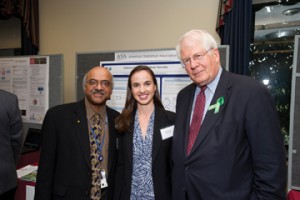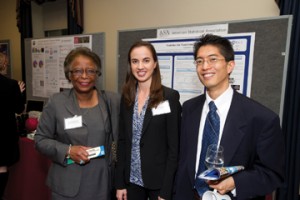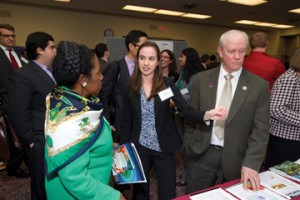ASA Takes Part in Annual Capitol Hill Exhibition
Steve Pierson, ASA Director of Science Policy

Sastry Pantula, director of the NSF Division of Mathematical Sciences; Genevera Allen; and Rep. David Price (D-NC)

From left: Cora Marrett, NSF acting director; Genevera Allen; and Richard Yamada, professional staff of the House Science, Space, and Technology Committee
For the fourth consecutive year, the American Statistical Association (ASA) participated in the annual Capitol Hill Exhibition May 7 sponsored by the Coalition for National Science Funding (CNSF). CNSF is a coalition of 130 professional societies, universities, and other stakeholders who work together to support the budget of the National Science Foundation (NSF). The annual event started in 1995.
Hosted in a House office building across from the U.S. Capitol, this year’s event showed off NSF-funded research from 36 groups to members of Congress and their staffs. It was attended by nearly 300 people, including 10 members of Congress.
Representing the ASA was Genevera Allen of the Rice University Department of Statistics and Electrical and Computer Engineering and the Neurological Research Institute at the Baylor College of Medicine. Allen’s poster described her work on functional brain connectivity and was especially interesting to those attending the exhibit because of its relevance to the Obama Administration’s Brain Research through Advancing Innovative Neurotechnologies (BRAIN) Initiative and the White House Office of Science and Technology Big Data initiative (per subject, fMRI produces about four gigabytes of data).
Prior to the evening reception, Allen and ASA Director of Science Policy Steve Pierson visited six congressional offices: Sen. John Cornyn (R-TX), Rep. John Culberson (R-TX), Rep. Sheila Jackson Lee (D-TX), a majority staffer for the Commerce, Justice, Science (CJS) subcommittee of the House Appropriations Committee, and minority and majority staffers for the House Science, Space, and Technology Committee. They visited Culberson because he serves on the CJS appropriation subcommittee, which has authority over NSF’s budget, and his district is adjacent to Rice University.
Overall, Allen’s meetings went well. Staffers understood the importance of NSF funding and its benefit to the country. The general feedback, however, was that it would be hard to realize the requested increase of more than 10% for NSF’s budget for fiscal year 2014 (FY14). Indeed, there seemed little optimism that this would be the year Congress would finalize some of the budget for FY14 before it begins October 1. In other words, the federal government will again operate on a continuing resolution for part of the fiscal year.
At the evening reception, Allen explained her research to a steady stream of people, including members of Congress, NSF officials, congressional staff, and fellow exhibitors.
Besides her interesting research topic, Allen made a compelling story about the importance of NSF funding because she attended Rice University as an undergrad intending to major in music. It was through an NSF program—Vertical Integration of Research and Education in the Mathematical Sciences (VIGRE)—that she became involved in a summer research program that hooked her on a career in statistics. Even her graduate work at Stanford University was supported by the VIGRE program.
Allen was also an excellent representative of the statistics profession. She epitomized the statistician at the center of a multidisciplinary team performing cutting-edge research and effectively communicated the importance of having a statistician as part of such a team to tackle many of today’s key research challenges.
After her long, effective day of advocacy for science, statistics, and funding on the Hill, Allen commented, “It was a tremendously valuable experience, and I feel I learned so much about how the science policy system works. I will encourage my colleagues to be more vocal on these issues to their elected officials.”
Visit Scavone Photography website to view more pictures of the exhibit.


















